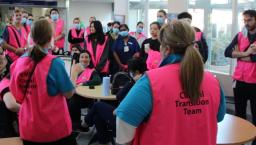HHS opens digital health infrastructure security RFP

Photo by: Science Photo Library/Getty Images
Through a broad agency announcement about the Scaling Health Applications Research for Everyone solicitation, the U.S. Health and Human Services office of the Advanced Research Projects Agency for Health is seeking to adapt Department of Defense and other related government agency health innovations in order to transform civilian healthcare.
WHY IT MATTERS
ARPA-H announced that, through a Digital Health Security project, which the office is calling DIGIHEALS, HHS aims to ensure all patients continue to receive care in the wake of a medical facility cyberattack.
To protect the U.S. healthcare system’s electronic infrastructure – under attack from a complex fabric of cyber actors that seek profit, political gains and/or disruptions to the U.S. healthcare system – the BAA solicits proposals to apply "proven technologies developed for national security" to health systems, clinical care facilities and personal health devices.
"The DIGIHEALS project comes when the U.S. healthcare system urgently requires rigorous cybersecurity capabilities to protect patient privacy, safety and lives," Renee Wegrzyn, ARPA-H's inaugural director, said in a statement earlier this month.
"Currently, off-the-shelf software tools fall short in detecting emerging cyber threats and protecting our medical facilities, resulting in a technical gap we seek to bridge with this initiative."
The three areas of interest listed in the BAA relate to securing healthcare systems and data:
- Under "Buttressing the Security of Digital Health Technology," the BAA seeks to develop capabilities for finding flaws and rapidly patching legacy binaries in mission-critical systems. Technologies that can analyze, modify and fix legacy software in binary form and can produce "assured targeted micropatches for known security flaws in existing binaries" are specifically noted.
- Under "Gathering Insights Through Novel Approaches to Data and Analytics,” the BAA seeks the development of novel verified programming methodologies for building data fitness technologies, including artificial intelligence or machine learning techniques, that can comprehend, simplify and reduce data formats to "their safe, unambiguous, interoperability-enabling and verification-friendly subsets ('safe sub-setting').”
- Under "Rapidly Developing Secure Digital Health Technology," the BAA seeks the development of software developer-accessible capabilities that can enable making system enhancements with new verified code.
As expected, there is an extensive proposal adequacy checklist and description of the capabilities required. However, because the initiative is expected to build on what Defense Advanced Research Projects Agency, the Defense Innovation Unit and other government entities have achieved, applicants "MUST" demonstrate technical feasibility, benefit healthcare delivery and align with ARPA-H's mission.
The solicitation notes that applicants must also have prior success within a DoD or federal government context – "substantiated" by advancements such as U.S. Food and Drug Administration approvals, an R&D plan for a prototype that adapts existing technology for healthcare population beneficiaries and is in line with one or more of the office's focus areas – health science futures, scalable solutions, proactive health and resilient health systems.
Applications are due on SAM.gov by September 7.
THE LARGER TREND
Past federal funding to develop health analytics and other technologies has been large, such as the $5.1 million DARPA gave Kryptowire for smartphone-based health tracking in 2018.
More recently, DoD appropriated $10 million to the DIU's Defense Threat Reduction Agency's Rapid Assessment of Threat Exposure project to further develop RATE algorithms – used to analyze biometric data from commercial wearables and predict infections up to 48 hours before service members' symptoms appeared during the COVID-19 pandemic – to scale the system to 100,000 military users and shortlist more wearables.
Navin Natoewal, head of integrated technology solutions, intellectual property and standards at Philips, told Healthcare IT News in May that in the future, AI and wearables that can detect illness before symptoms start have implications for remote patient monitoring. He noted that Philips was working with DoD to launch an application with occupational health but at the time, no launch date was set.
ON THE RECORD
"By adapting and extending security, usability and software assurance technologies, this digital health security effort will play a crucial role in addressing vulnerabilities in health systems," said Andrew Carney, ARPA-H's program manager and former DARPA technical advisor and contractor.
"This project will also help us identify technical limitations of future technology deployments and contribute to the development of new innovations in digital security to better keep our health systems and patients’ information secure."
Andrea Fox is senior editor of Healthcare IT News.
Email: afox@himss.org
Healthcare IT News is a HIMSS Media publication.
























